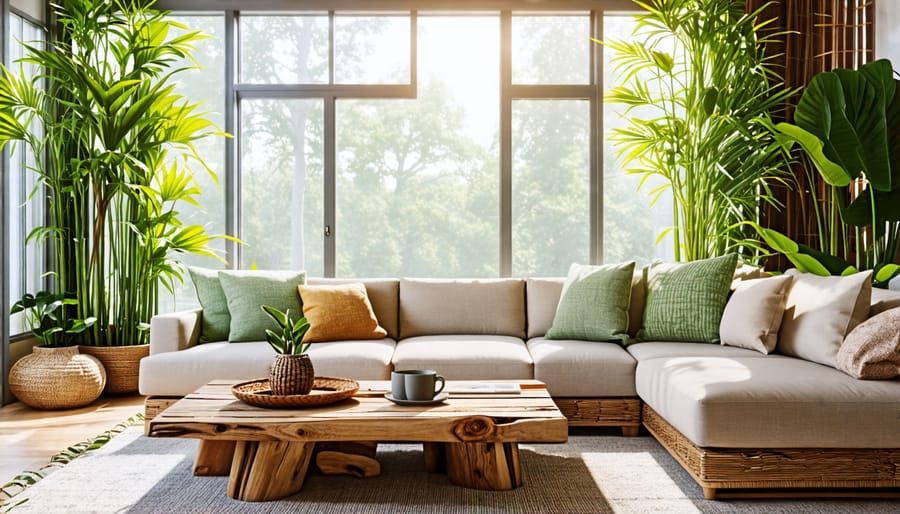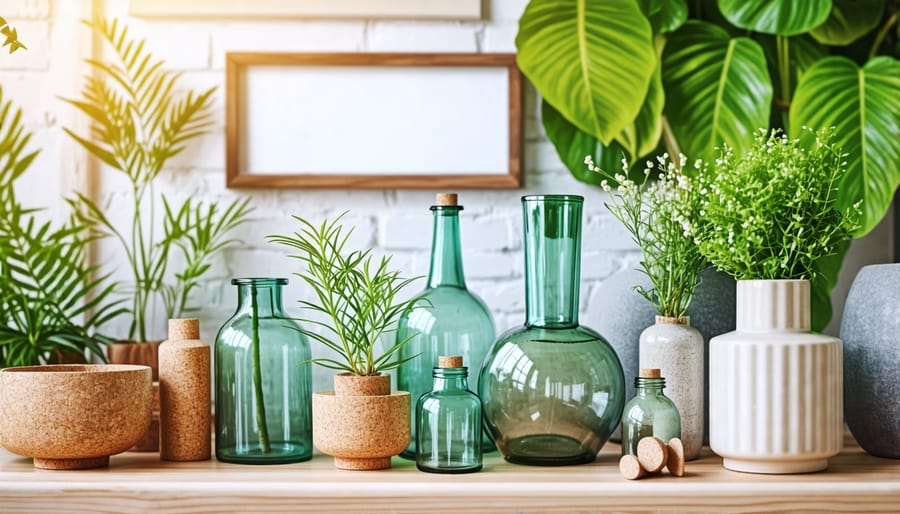Choose sustainable materials like bamboo, reclaimed wood, and organic cotton for furniture and fabrics. Install energy-efficient LED lighting and solar-powered accents to reduce your environmental footprint. Embrace a minimalist aesthetic by decluttering and focusing on high-quality, multi-functional pieces that stand the test of time. Incorporate natural elements such as living plants, stone, and eco-friendly fibers to create a harmonious, sustainable home decor scheme that reflects your values and style.
Reclaimed Wood Furniture
Reclaimed wood furniture is a beautiful and eco-friendly way to bring warmth, character, and sustainability into your home. By repurposing wood from old barns, warehouses, or other structures, you can enjoy unique pieces that tell a story while reducing the demand for new lumber. Reclaimed wood offers a timeless, rustic charm that suits many decor styles, from farmhouse to industrial chic.
When sourcing reclaimed wood furniture, look for pieces made by reputable artisans who prioritize quality craftsmanship and sustainable practices. Check for a smooth finish to ensure the wood has been properly treated and is free of splinters or rough patches. Reclaimed wood dining tables, coffee tables, and shelving units are popular choices that add natural texture and visual interest to your space.
For a more subtle touch of reclaimed wood, consider smaller accents like picture frames, mirror frames, or decorative boxes. These elements can complement your existing furniture while adding an eco-conscious flair to your decor. When purchasing reclaimed wood pieces, don’t be afraid to ask about the wood’s origin and the artisan’s production methods to ensure you’re getting a genuinely sustainable product. With a little research and careful selection, reclaimed wood furniture can be a stunning and responsible addition to your home.

Organic and Natural Fabrics
When choosing fabrics for your home, opting for organic cotton, linen, wool, and other natural materials can make a significant difference in your journey towards sustainable living. These eco-friendly textiles are not only gentler on the environment but also offer a range of benefits for your home and family. Organic cotton is grown without harmful pesticides and chemicals, making it a healthier choice for bedding, curtains, and upholstery. Its breathable and hypoallergenic properties ensure a comfortable and restful environment.
Linen, derived from flax plants, is another sustainable option that is naturally moisture-wicking, antibacterial, and durable. Its timeless elegance adds a touch of sophistication to any room. Wool, sourced from sheep, is a renewable and biodegradable material that offers excellent insulation and temperature regulation. It’s perfect for cozy throws, area rugs, and even upholstery.
When shopping for these natural fabrics, look for certifications such as GOTS (Global Organic Textile Standard) or OEKO-TEX, which ensure the materials meet strict environmental and social criteria. By incorporating these sustainable fabrics into your home decor, you’re not only creating a stylish and inviting space but also contributing to a greener future.

Energy-Efficient Lighting
One of the simplest ways to make your home more sustainable is by switching to energy-efficient LED lighting. LED bulbs use 75% less energy than traditional incandescent lights and can last up to 25 times longer, significantly reducing your carbon footprint and electricity bills. When selecting LED bulbs, look for options with warm color temperatures (2700-3000K) for a cozy ambiance in living spaces and bedrooms, and cooler temperatures (4000-5000K) for task lighting in kitchens and home offices.
Smart home lighting automation takes energy savings a step further. By installing smart light switches or bulbs, you can control your lights remotely via smartphone apps or voice assistants, ensuring they’re only on when needed. Set schedules to automatically turn off lights during daylight hours or when rooms are unoccupied. Motion sensors and dimmers can also help optimize lighting usage. Plus, many smart lighting systems allow you to create customized scenes and adjust color temperature for a personalized, eco-friendly ambiance throughout your home.
Low-VOC Paints and Finishes
When selecting paints, stains, and finishes for your sustainable home, prioritize products with low volatile organic compounds (VOCs). VOCs are chemicals that off-gas into the air, potentially causing health issues and negatively impacting indoor air quality. Many conventional paints contain high levels of VOCs, but fortunately, there are now numerous low-VOC and zero-VOC options available. These eco-friendly alternatives provide the same quality and durability as traditional paints without the harmful emissions. When shopping for paints and finishes, look for products labeled as low-VOC or zero-VOC, or seek out natural, plant-based options like milk paint or clay paint. By choosing low-VOC products, you can create a healthier, more sustainable living environment while still achieving the desired aesthetic for your home.
Recycled Glass and Metal Accents
Recycled glass and metal offer a stunning and sustainable way to add unique flair to your home decor. Tiles made from recycled glass bring a shimmering, iridescent quality to backsplashes, shower walls, or even as accent pieces in flooring. Look for cabinet knobs and drawer pulls crafted from reclaimed metal for an industrial-chic touch that’s both eco-friendly and stylish. Vases and bowls made from recycled glass make beautiful centerpieces on dining tables or eye-catching displays on shelves. Artwork created with salvaged metal adds a sculptural element to your walls while telling a story of sustainability. By choosing recycled glass and metal accents, you can infuse your space with character and charm while feeling good about reducing waste and supporting artisans who prioritize environmental responsibility. Keep an eye out for these distinctive, earth-friendly elements at home goods stores, artisan markets, and online retailers specializing in sustainable decor.

Bamboo and Cork
Bamboo and cork are two highly sustainable materials that make excellent choices for eco-friendly home decor. Bamboo is a fast-growing grass that regenerates quickly after harvesting, making it an incredibly renewable resource. It’s also durable, moisture-resistant, and stylish, perfect for flooring, furniture, and decorative items like window blinds or wall art. Cork, harvested from the bark of cork oak trees without harming the tree, is another green option. It’s naturally insulating, sound-absorbing, and comfortable underfoot, ideal for flooring or wall tiles. Cork’s unique texture also lends itself well to vintage items like coasters, trivets, or even furniture pieces. By incorporating bamboo and cork elements throughout your home, you can create a warm, inviting space that’s also environmentally responsible.
Vintage and Antique Decor
One of the most sustainable ways to decorate your home is by giving new life to quality vintage and antique pieces. Not only does this keep furniture and decor out of landfills, but it also adds unique character to your space. When antiquing, look for well-made items crafted from durable materials like solid wood, metal, and glass. Inspect pieces for signs of quality construction, such as dovetail joints in drawers, hand-tied upholstery springs, and smooth, even finishes.
Don’t be deterred by cosmetic wear – a fresh coat of paint or new hardware can completely transform a piece. Mix and match eras and styles for an eclectic, collected look in your stylish, earth-friendly home. Vintage textiles like curtains, quilts, and rugs are another great way to add sustainable style. Look for items made from natural fibers and with colors or patterns you love. With a discerning eye and a bit of creativity, you can create a one-of-a-kind space filled with storied pieces that reflect your personal style while minimizing your environmental impact.
Conclusion
Creating a sustainable, stylish home is easier than you might think. By incorporating natural materials, repurposing items, choosing energy-efficient lighting, and opting for eco-friendly fabrics, you can transform your space into an earth-friendly haven without compromising on aesthetics. Remember, even small changes like swapping plastic for bamboo or choosing organic cotton can make a big difference. With a little creativity and mindfulness, you can craft a beautiful, sustainable home that reflects your unique style while minimizing your environmental impact. Embrace the challenge and enjoy the process of building a greener, more conscientious living space one décor choice at a time.
